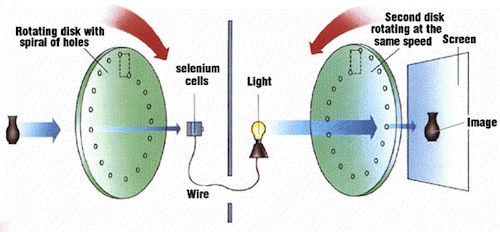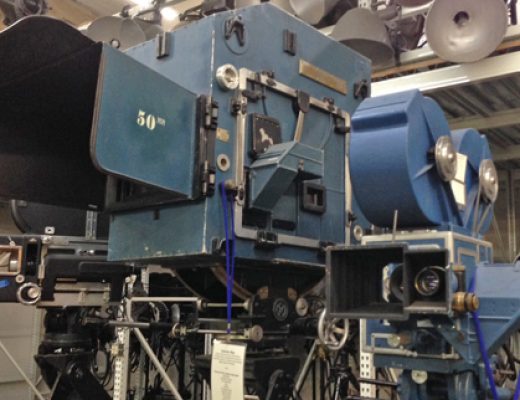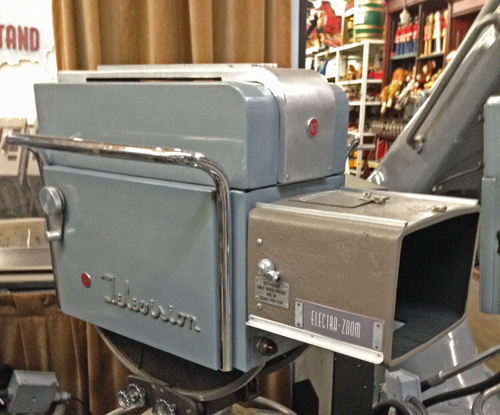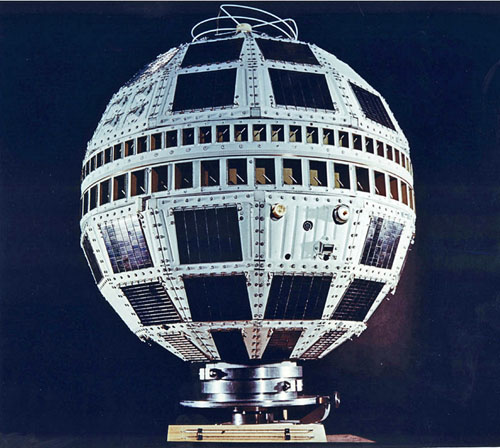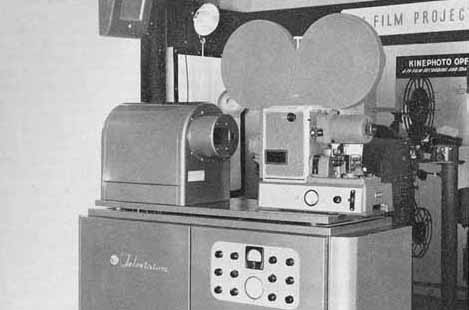Mechanical television. Does that mean motors, pulleys, gears and other moving parts? Why, yes. It does.
Long before television as we know it today, even before television’s commercial beginnings as some of us remember it, and even before that, just as radio was beginning, there were talented people experimenting with mechanical contraptions to send pictures through the air. The signal was still completely electrical, but the method of getting a picture to ride on a wire began as a collection of spinning disks.
In 1873, the element selenium was discovered to have the capacity to generate a current based on the amount of light applied to it. Selenium cells followed quickly and inventors began looking for uses for this new way of handling electricity. Early facsimile transmission (aka FAX’s) of still pictures was one early application for selenium cells. In 1881, English inventor Sheldon Bidwell demonstrated just such a system.
In an article Bidwell later wrote for Nature magazine in 1908 titled “Telegraphic Photography,” he reported on experiments of other scientists attempting to break down live motion pictures for transmission. In the article Bidwell outlined the difficulties confronting those researchers as they attempted to develop “distant electric vision.” He described how a picture represented a large volume of data. To rapidly change the data to create motion would require a complex, expensive device and a large number of circuits in order to break down the pictures into the thousands of elements required.
Among the first inventors tackling this problem was Paul Nipkow, a German Engineering student, who in 1884 patented the first mechanical television system. Nipkow came up with the idea of “scanning” a television image by using a spinning disk with a spiral of small sequentially arranged pinholes. When spun at a high rate of speed, each hole would allow light to fall on a selenium cell. The amount of voltage the cell generated would depend on the amount of light reflected from the object being photographed. Lighter areas would produce a higher voltage and darker areas lower voltage. One rotation of the disk equaled one frame of “video.”
The Nipkow disk is a rotating disk with holes punched at regular intervals in a spiral configuration. When spun at high speed, light shining through the holes appears to scan an object.
At the receiver, the process would be reversed. A similar disk spun in sync with the camera. The photosensitive cell was replaced with a neon lamp as it reacted to the changes in voltage with the speed required to keep up with the spinning disk.
It’s doubtful Nipkow ever built a working prototype of the system he patented. Without amplification the circuit would have been very weak. It wasn’t until 1906 when Lee DeForest developed the Audion tube and allowed circuits to be amplified. With the addition of an amplifier, Nipkow’s concept became more practical. Most later experimenter’s drew on Nipkow’s spinning disk concept adding circuits to amplify the weak voltage of the selenium cell. From this, they built prototypes of their designs.
Of the first versions to actually produce recognizable images, it’s a toss up as to whether it was American inventor Charles Francis Jenkins or a Scottish inventor, John Logie Baird who had the first real success. Working independently of each other an ocean apart, Jenkins, who at the time was best known for inventing the motion picture projector, first transmitted a silhouette picture from one room to another in 1922. In 1924, Baird conveyed a flickering image a few feet using a design he set up on a “coffin board” used by undertakers to move bodies around.
Improvements in both designs came quickly and by 1928, Jenkins received an experimental license (W3XK) from the US Federal Communications Commission. He founded the Jenkins Television Corporation and began broadcasting his “radiomovies” on short wave frequencies across the east coast of the United States transmitting 48 lines at 15 frames per second. Jenkins’ company sold several thousand of his “radiovisors” costing between $85 and $135. But the financial crash of 1929 forced him out of business.
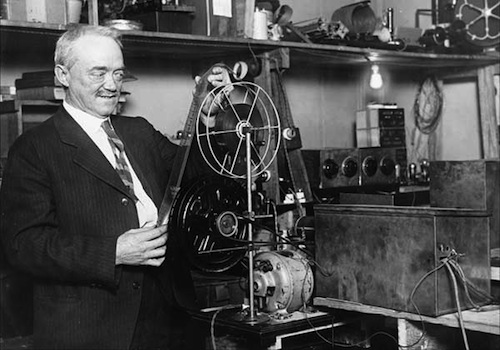
Charles Francis Jenkins is recognized as putting the first television station on the air in the United States in 1928. He was also the inventor of the motion picture projector. His basic design was still in use in most movie theaters until the digital tipping point.
Baird, on the other hand, assembled his experiments using simple items such as the top of a hatbox, simple motors and other things found around the house at the time. During his experiments, he used so much light, his human models quit, refusing to be put through the uncomfortable experience. He substituted a vetroliquist’s dummy and named him Stookie Bill. Baird gave his first public demonstration a couple years earlier than Jenkins and by 1928, he made the first transatlantic television transmission via short wave. In that same year, Baird demonstrated both mechanical color television using a modified Nipkow disc and early stereoscopic (3D) television.
One year later he started regular 30-line mechanical broadcasts at 12.5 frames per second using a BBC transmitter. The high powered transmitter ceased its regular BBC programing at eleven at night and did not resume until mid morning. By the end of 1929, Baird was running a regular program schedule using this transmission facility. Baird had a troubled relationship with the BBC but he must be given some credit for the fact that 20,000 television sets were in use in Great Britain just 14 years after the first public demonstration of his system.
In 1930, the BBC made a second transmitter available to Baird and the inventor was able to program simultaneous sound and picture transmissions. Those early telecasts were silent as the bandwidth only allowed the transmission to be either sound OR picture but not both together. In the U.S., Jenkins system experimenters (who made up most of the early viewing audience), were using radios adapted to also show the television signal. They would be cued to throw a switch either by voice to switch to video or by an on screen slide to switch back to audio.
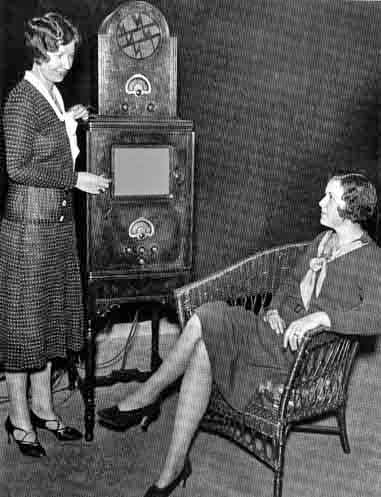
The Jenkins 1931 Universal Television Receiver combined video & audio together for the first time. (From Television History – The First 75 Years www.tvhistory.tv)
The man credited with inventing electronic television, Philo T. Farnsworth, saw the limitations in using the Nipkow disk to create mechanically generated images early on. He went about his research to find a way to make electrons do the work of image dissection at the speed of light thereby making increased resolution possible. In fact, the camera tube he designed was called the Image Dissector. His success sounded a death knell for mechanical television.
Today those early mechanical receivers such as the Jenkins’ Radiovisor or Laird’s Televisor are museum pieces, but not just in the form of interesting furniture. Several collectors have developed ways to restore some sets to working condition and, using computer programs to provide a wide jump between the old and the new, have been able to reproduce authentic images on them. The Laird Televisor at the Early Television Foundation and Museum in Hilliard, Ohio, is just such an example.
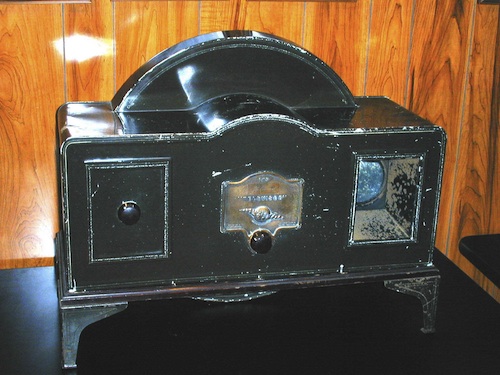
This model has been restored by the Early Television Foundation and is in operational condition. It is on display in their Museum in Hilliard, Ohio. Courtesy Steve McVoy and the Early Television Foundation.
But even though all electronic television quickly demonstrated the ability to captivate the public, the story of mechanical elements in television did not end here.
Cut to the early 1940’s. Just as commercial television was getting underway, many proponents had decided the industry shouldn’t be limited to black and white pictures and that color should be the standard from the beginning. By then, Baird had refined his television system and was able to demonstrate a color version using a color wheel system in 1940.
Dr. Peter Goldmark, Chief Television Engineer for CBS had visited Baird while working on his advanced studies in physics in the early 1930’s. He was unable to find work with Baird and went to work for Pye Radio, Ltd. instead. Later he immigrated to the United States and went to work with CBS. The same year Baird demonstrated his color wheel system, Goldmark, demonstrated his color television using a hybrid system of all electronic black and white (using a Farnsworth Image Dissector tube) with an added color wheel of the three primary colors (red, green and blue). The wheel rotated fast enough to project a color image at 20 frames per second. However, World War II was looming and work on color television was halted so resources could be redirected to the war effort.
After the war, Goldmark returned to his work on the field sequential approach to color television. Closed circuit television was just being introduced in medical schools. When it became apparent black and white would not be sufficient for teaching, Goldmark developed a demonstration system he successfully showed at the American Medical Association’s annual meeting in 1949. With this success, he and CBS submitted a proposal to the U.S. Federal Communications Commission for adoption of their color system.
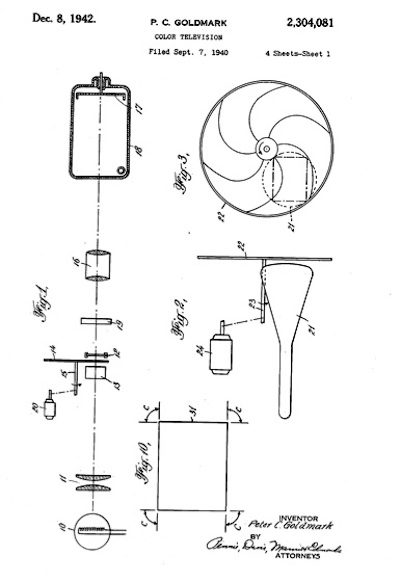
Dr. Goldmark’s U.S. Patent diagram of CBS’s field sequential color system. The camera is on the left with the spinning color wheel just lower center. On the right is the receiver. The spiral in the upper right is the much larger color wheel for viewing. Both wheels have repeating segments of the primary colors (red, green & blue). The system operated at a frame rate that made it incompatible with black and white televisions already in the marketplace.
Two other systems were in contention. RCA was working on an all-electronic system (Dot Sequential) and a system from Color Television, Incorporated, a company formed solely to create a color television system, advanced a Line Sequential system that was all electronic and compatible. As it was written at the time, the system lacked good color registry, definition and intensity.
On October 11th, 1950, the FCC declared CBS’s Field Sequential Color Television System to be the national standard. RCA sued to halt CBS from going forward. However, RCA’s all-electronic system was not as good as the CBS system at the time and CBS won the lawsuit. In June of 1951, CBS began color programming to a five station network along the east coast of the United States.
Goldmark’s system increased television’s frame rate from 60 to 144 fields per second resulting in 24 complete frames per second (to accommodate the transmission of three complete versions of each field to accommodate each primary color). To accommodate a television channel’s 6MHz bandwidth, picture resolution had to be dropped from 525 lines to 405 lines.
The intervening years since 1940 had seen television’s commercialization and amazing growth to 10 million television receivers. The incompatible system would render every existing television receiver in the nation obsolete. Viewers attempting to receive a CBS Colorcast would only see a gray screen. Manufacturers, already tooled for the black and white standard, refused to build hybrid sets arguing they would be prohibitively expensive.
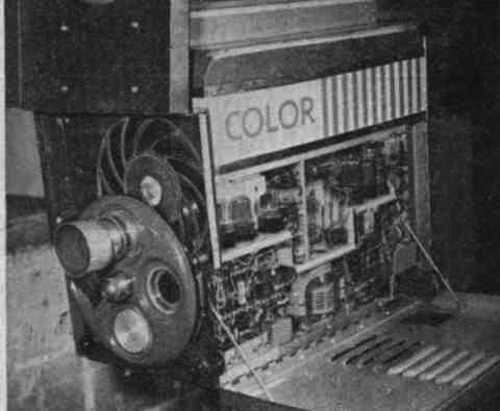
The CBS Field Sequential color system lasted less than six months, but a considerable amount of work went into the production equipment. This is a modified RCA TK-10 studio camera. Notice the wheel behind the top lens. It holds the red, green and blue filters needed to make the separate fields later reassembled in the receiver equipped with a corresponding disk and produce a color image.
Again, war played a factor in the development of television. Tensions in Korea were mounting and, with the outbreak of the Korean Conflict, the U.S. Government banned the sale of color receivers. The last CBS color system broadcast took place on October 20, 1951, with a football game between North Carolina and Maryland. Ironically, it is the same day the iconic CBS Eye made its first appearance on the airwaves. It would go on to become the most successful corporate logo in the history of American business.
During the two year period of the ban, RCA worked on improving its color system as black and white televisions continued to fly out of the showrooms. When the color receiver ban was lifted two years later, CBS did not challenge the adoption of an RCA/National Television Systems Committee recommended system that became the television standard for next 56 years.
But wait. Mechanical television wasn’t dead yet. It still had one last breath.
When America’s National Aeronautics and Space Administration (NASA) began planning the Manned Moon Missions, they realized television would have to be along so the world would be able to see what the astronauts saw. And while space, weight and bandwidth considerations prohibited the public from witnessing the first steps of man on the moon in color, NASA wanted a color camera on board the Apollo Command Capsule orbiting above.
All the major players were in contention for the rights to build the cameras. Westinghouse Electric Corporation won the bid. As they looked for ways to save weight and bandwidth, they revisited the system’s that had gone before.
Re-enter Goldmark’s Field Sequential System.
Westinghouse’s Lunar camera project manager Stanley Lebar told TV Technology magazine in 2009, “The team came up with the idea of using a self-contained color wheel unit that would slip over the lens for field sequential color.”
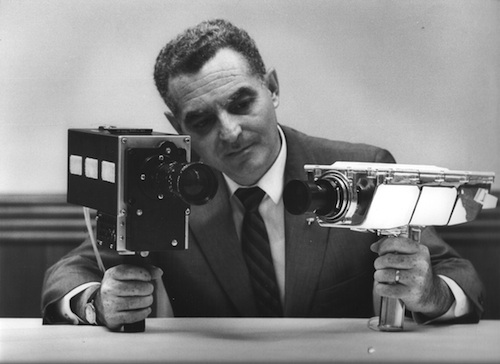
Stanley Lebar, Westinghouse’s project manager on the Apollo television camera project, holds the field sequential color camera on the left and the black and white version on the right. NASA Photo.
The Westinghouse engineers made modifications to the system to bring into specification with NASA’s requirements. Since the signal downlinked from space was in the form of telemetry data, the incompatibility suffered by CBS was not a problem for NASA. A converter was built to extract the TV signal and deliver it to the world’s television networks. Later, a color camera would be added to the Lunar Excursion Module for future moon missions.
As video has given way to digital and film continues to go the way of the Dodo bird, there is very little left that is mechanical in the world of media. Appreciation must be extended to specialty niche museums like the Early Television Foundation and Museum, the Museum of Broadcast Technology and others who continue to keep the dinosaurs of television living and breathing.

Filmtools
Filmmakers go-to destination for pre-production, production & post production equipment!
Shop Now